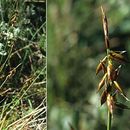en
names in breadcrumbs


Carex pulicaris, the flea sedge, is a species of sedge in the genus Carex native to Europe.
Carex pulicaris is a small sedge, with stiff stems 10–30 centimetres (4–12 in) tall.[1] The leaves are 5–25 cm (2–10 in) long and less than 1 millimetre (0.04 in) wide.[1] The inflorescence comprises a single spike, with 3–10 female flowers towards the base, and male flowers towards the tip.[1][2] As the utricles mature, they bend away from the spike axis and become sensitive to touch; the way the seeds appear to jump from the stem gives rise to the plant's vernacular name.[1] Before the utricles have become deflexed, C. pulicaris closely resembles C. rupestris, with which it often grows.[1] It may also be confused with C. pauciflora, which usually bears only 2–3 fruit per stem.[2]
Carex pulicaris is found across much of Europe, from Spain to Estonia and north to Iceland and Fennoscandia, but excluding the Mediterranean region.[3] It grows in a variety of wet habitats, including bogs, fens and wet flushes.[4]
Carex pulicaris was first described in Carl Linnaeus in his 1753 work Species Plantarum. It is not known to hybridise with any other species.[1]